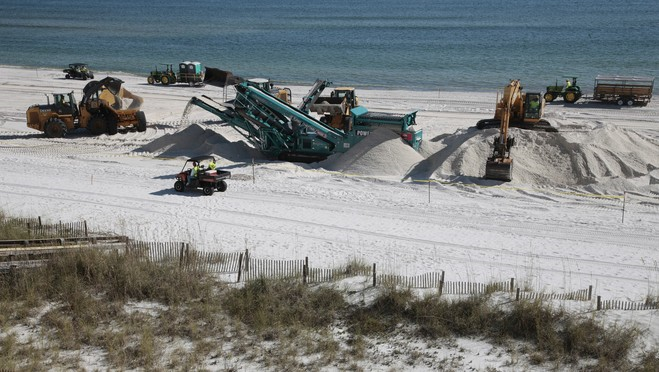BP deep-cleaning Gulf coast beaches amid new worries
The Associated Press
November 17, 2010 ORANGE BEACH, Ala. (AP) — With its Macondo well dead and few visitors on the coast during the offseason, BP has launched its biggest push yet to deep-clean the tourist beaches that were coated with crude during the worst of the Gulf oil spill. Machines are digging down into the sand to remove buried tar mats left from the Deepwater Horizon disaster. What’s typically a beautiful, quiet stretch of beach in the fall now resembles a construction site. Bulldozers and yellow dump trucks shake the ground; a giant sifting machine spits clean sand out one end, tar balls out another. The work is getting mixed reviews. Many are anxious to see the beaches cleaned as quickly as possible by whatever means are available. Others say BP may be making matters worse by bringing heavy equipment onto beaches and spreading the petroleum stain. Some fear fresh environmental damage from the work itself, which can kill tiny creatures that live in the sand. Even BP acknowledges that fresh tar balls are still hitting the coast, meaning some of the work might be premature. Still, local officials have given the company a Jan. 1 deadline to be done. … A few miles away at Perdido Key, Fla., longtime resident Terry Hanners has his doubts. He sees what appears to be an ever-expanding oil stain on the beach and fears the once-white sand will remain its current brownish tint, which is close to the color of weak tea. “They’re just spreading it,” said Hanners. “We have a stain that’s going to stay with us a while.” … Today, machines resembling agricultural harvesters move slowly along the beach digging about 18 inches below the surface in search of buried oil. Sand is lifted by a conveyor system and dumped onto screens; clean sand is expelled from the contraption, called a Sand Shark, while rust-colored tar balls, broken shells and other trash collect in a bin. Workers are using a much larger cleaning system called a Powerscreen to scrub broader areas of beach. Dozers pile up sand, which a big machine with a bucket dumps into the sifter. Cleaned sand is ejected by one belt while tar and other material goes another way. Workers have dug down about 30 inches so far to find oil, and officials say the dozers can dig as deep as needed to get the worst of the oil deposits. Different, gentler cleaning methods will be used in more delicate areas like Mississippi’s coastal islands and the marshlands of Louisiana, the company says. … The work has raised concern among environmentalists who fear the heavy machinery will kill creatures that live on the beach or cause erosion problems as the natural lay of the land is disturbed. Marine scientist George Crozier says the work is doing some damage, like killing small ghost crabs that live in the dry sand. “Certainly there’s going to be a lot of impact, but I don’t know if it’s going to be significant impact,” said Crozier, the longtime head of the Dauphin Island Sea Lab. He favors letting the buried oil remain where it is: buried. …
BP deep-cleaning Gulf coast beaches amid new worries
